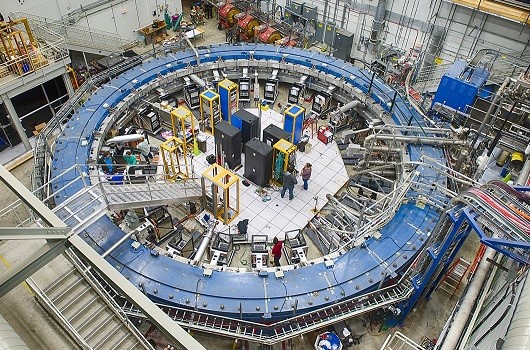Shedding light on the muon’s magnetic moment puzzle
 The ring of the Muon g-2 experiment at Fermilab near Chicago (USA)
The ring of the Muon g-2 experiment at Fermilab near Chicago (USA)
Has the Standard Model, the theory of particle physics, broken down? Physicists have been asking this question since the publication of the first results of the Muon g-2 experiment on April 7. This experiment takes place in the particle accelerator at Fermilab, near Chicago. It studies muons, elementary particles similar to electrons but 200 times more massive. "It aims at measuring the magnetic moment of these particles, i.e. the intensity with which they couple to a magnetic field" explains Emilian Dudas of the Center for Theoretical Physics (CPHT*), who attended the seminar presenting the results. But this magnetic moment deviates from the Standard Model’s theoretical prediction. "It is an old puzzle because Fermilab’s team reproduces an experiment halted in 2001 at the Brookhaven laboratory that already pointed to a disagreement between theory and experiment."
But it is still necessary to ensure that this disagreement is significant because, like any measurement, the result has an error bar. Moreover, it could be a statistical fluctuation that could emerge in these quantum measurements which include an intrinsic randomness. In the past, some deviations of this kind have proven to be false alarms. Repeating the measurement a large number of times reduces this possibility. "It makes sense to combine Brookhaven and Fermilab measurements because it is the same machine, although it has been moved and improved in the meantime. So the probability that this is a statistical fluctuation is less than one in 40,000. This is getting serious" the scientist points out. In the physicists’ language, the difference between theory and experiment stands at 4.2 "sigmas". By convention, particle physicists wait until the gap exceeds 5 sigmas before announcing a discovery, as for the Higgs boson in 2012.
Another point encourages us to wait before announcing the breakdown of the Standard Model: the uncertainties on the result do not only come from the experiment, but also from the theoretical calculation. This is due to the influence exerted on the muons by all the other particles of the Standard Model, which "virtually" exist in the experiment because of quantum physics. "Since the muon is 200 times more massive than the electron, the quantum corrections brought by the particles feeling the strong interaction cannot be put aside ". Precisely this makes the theoretical calculation particularly difficult. However, the same day Fermilab’ s team announced its result, another team published a new theoretical calculation, carried out with a different method. "According to this new calculation, the conflict between theory and experiment is much less! It will take time to know what is really going on, but in any case, it is interesting" continues the theoretical physicist.
Scientists have been trying for a long time to challenge the Standard Model of particle physics. Its predictions have been remarkable up to now - the Higgs boson for example - but we know it is incomplete. In particular, it does not explain the dark matter that seems to make up a large part of the Universe. Unknown particles or interactions would also influence the value of the muon’s magnetic moment and explain the conflict. "This is why many models going beyond the current theory have been published on arXiv after the announcement of Fermilab. For my part, I am particularly interested in models that use supersymmetry, which predicts the existence of "twins" to particles known today." Supersymmetry is also an essential ingredient in string theory, a speculative physical theory that is at the heart of Emilian Dudas' team research. But there are other possibilities. Both experimental and theoretical investigations continue.
*CPHT: a joint research unit CNRS, École Polytechnique - Institut Polytechnique de Paris
 Support l'X
Support l'X